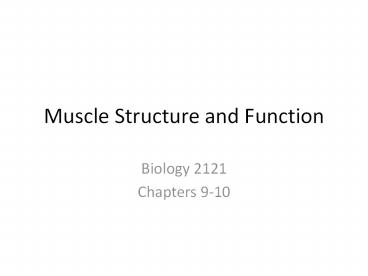Muscle Structure and Function - PowerPoint PPT Presentation
1 / 24
Title:
Muscle Structure and Function
Description:
Muscle Structure and Function Biology 2121 Chapters 9-10 Chest and Shoulder Group Abdominals Quadriceps and Hamstring Group Gross Anatomy Microscopic Anatomy ... – PowerPoint PPT presentation
Number of Views:165
Avg rating:3.0/5.0
Title: Muscle Structure and Function
1
Muscle Structure and Function
- Biology 2121
- Chapters 9-10
2
Introduction
- 1. Functions
- Movement, Posture Heat and Joints
- 2. Naming (321)
- Location Shape (temporalis deltoid)
- Size (gluteus maximus)
- Fiber Direction (abdominus rectus)
- Origins (bicep)
- Location of Attachment (sternocleidomastoid)
3
Major Muscle Groups
Chest and Shoulder Group
Abdominals
Quadriceps and Hamstring Group
4
Histology of Muscle Tissue- Skeletal Muscle
- Voluntary
- Found in major muscle groups
- Striated
- Multinucleated
- Peripheral
5
Smooth Muscle
- Involuntary
- Found in digestive system organs, bladder, etc.
- Non-Striated
- Uninucleated
- Spindle-Shaped nuclei
6
Cardiac Muscle
- Involuntary
- Heart only
- Branching Fibers
- Uni-Nucleated
7
Gross Anatomy
- 1. Whole muscle
- Epimysium
- 2. Fascicles
- Perimysium
- 3. Muscle Fiber Cells
- Long and multi-nucleated
- Sarcolemma and sarcoplasma
- Endomysium
8
Attachments
- Tendons
- Aponeurosis
- Direct or Indirect Attachments
9
Microscopic Anatomy Myofibrils
- 1. Contractile proteins
- 2. Sarcomeres
- Actin and myosin
- 3. Myofilaments
- Actin (thin)
- Myosin (thick)
10
Sarcomere
- 1. A sarcomere
- Z to Z
- I-Band (light zone)
- A-Band (dark zone)
- 2. Structural Proteins
- Elastic filaments Titan
- 3. Sliding Filament Model of Contraction
- Link
11
Sarcomere Contraction
12
Chemical Stimulation and Muscle Contractions
- 1. Stimulation and Neurotransmitters
- Acetylcholine
- 2. Neuromuscular Junction
- Junction muscle/nerve interface
- Separation synapse
13
Neuromuscular Junction
14
Events at the Neuromuscular Junction
- 1. Nerve Impulse
- 2. Calcium ions Axon Terminal of Nerve
- 3. Vesicle and release of ACh
- 4. ACh receptors and Acetylcholinesterase
- 5. Sodium-Potassium exchange
- 6. Action Potential formed
15
Neuromuscular Junction
16
Action Potential
- 1. Resting Membrane
- -70 mV
- Na and K
- 2. Reversal of Charges
- Depolarization
- 3. Moves in one Direction
17
What Happens after the Action Potential is Formed?
18
Excitation and Contraction
- 1. Action Potential moves along the sarcolemma
- 2. Down the T-Tubule
- 3. Sarcoplasmic Reticulum and Release of Ca
- 4. Ca moves to the sarcomere
19
Formation of a Cross-Bridge
- 1. Ca interacts with troponin
- 2. Removes tropomyosin
- 3. Allows for Myosin Head Attachment
- 4. Formation of a cross- bridge
20
Cross-Bridge Cycling
- 1. Myosin heads attach forming cross- bridge
- 2. Working Stroke
- 3. ATP breaks cross- bridge
- 4. ATP hydrolysis
- 5. High-energy configuration New Cross-bridge
21
ATP and Muscle Metabolism
ATP Functions Driving Cellular Work
22
ATP Production
- 1. Creatine Phosphate Quick and Fast!!!
- 2. Anaerobic Respiration
- Lactic Acid Fermentation
- 1 glucose molecule 2 ATP Net
- 3. Aerobic Respiration
- 1 glucose molecule 36 ATP Net
- Mitochondria of the Cell
23
Aerobic Respiration
24
Fermentation
- Glycolysis
- (2) Pyruvic acid molecules (3-C)
- Blood flow restricted during vigorous exercise
(low oxygen) - Lactic acid formed
- Anaerobic glycolysis































